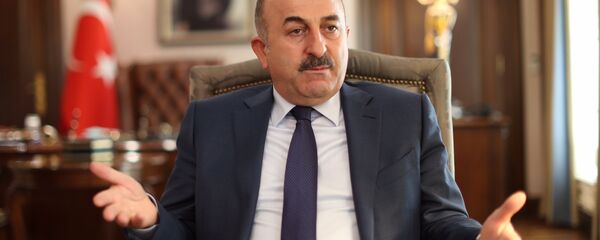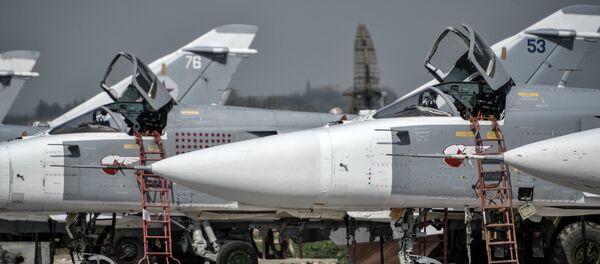On November 24, 2015, at 06:15 GMT, the Russian Aerospace Forces group deployed in Syria was ordered to hit terrorist targets in Syria’s Northern Latakia mountain region, where militants, mostly of Russian origin, were hiding.
At 06:42 GMT, two Sukhoi Su-24 combat aircraft took off from Hmeimim airfield to patrol a sector near Maarat al-Numan city in northwestern Syria.
Twenty minutes after the bombers reached their patrol sectors, the command center at Hmeimim Air Base ordered them to launch strikes at militant targets.
At 07:24 GMT, one of the aircraft navigated by Lt. Col. Oleg Peshkov hit an Daesh target located 3.4 miles to the south of the Turkish state border. The plane was later shot down by an air-to-air missile launched from a Turkish General Dynamics F-16 Fighting Falcon fighter that took off from Diyarbakir air base in Turkey.
According to Col. Gen. Viktor Bondarev, the commander of the Russian Aerospace Forces, Turkey’s F-16 fighters ambushed the Su-24 in the sky as they were otherwise unable to reach the area on time after taking off from the nearby airfield. He added that Russian Su-24 was tracked by a Turkish Air Force radar for 34 minutes.
At 07:25 GMT, the Russian officer in charge of flight operations noticed that Su-24 disappeared from an all-round visibility radar screen, while Peshkov did not respond to the officer’s requests or to those of the second bomber’s crew.
The commander and the navigator managed to eject before the plane hit the ground in an area where fighting raged between the Syrian army and terrorists.
Peshkov was killed by militants in mid-air since he landed near jihadist positions. Turkish citizen Alparslan Celik later claimed responsibility for the pilot’s murder.
Navigator Capt. Konstantin Murakhtin drifted in another direction, and militants were unable to hit him with their large-caliber machine guns. He landed unhurt and immediately switched off his emergency transponder, so that the militants could not capture him. Murakhtin knew that the Russian air base had already received his automatic distress signal. He walked over 3 miles in the mountains to escape from terrorists and eventually hid inside a camouflaged shelter.
A search-and-rescue operation was launched 15 minutes after it became clear that the Russian aircraft was down. The operation aiming to locate and evacuate the Russian pilots from the ground lasted over 12 hours.
The operation involved Russian and Syrian commandos and Mil Mi-8 Hip helicopters. One helicopter involved in the operation was hit by small arms fire and made an emergency landing on militant-controlled territory.
The helicopter was carrying a 12-person rescue team, including Russian marine Alexander Pozynich, who was killed during the rescue operation.
Syrian forces responded quickly, provided fire support to the Russian rescue team and later evacuated it and the helicopter’s crew. The helicopter was destroyed by mortar rounds from enemy-controlled territory.
The search-and-rescue operation aiming to locate the downed Russian bomber’s crew continued unabated.
Militants and some other units equipped with modern direction finders also operated actively in the vicinity. Murakhtin had to act very cautiously and he was unable to use his individual emergency USF (Ultra-Short Frequency) radio transceiver.
The rescue team managed to locate the downed pilot who used special equipment, having a special encryption system whose signals can only be picked up by special systems, while sending enemy soldiers in the opposite direction.
Due to this system, jihadists were unable to locate the Russian pilot, although they were very close to him at one point during their search.
The navigator managed to hold out for 12 hours on enemy territory and was eventually rescued by Russian marines and Syrian commandos.
Murakhtin returned to the Russian air base at about 01:00 GMT on November 25. Later the area of the operation was hit by Russian bombers and Syrian government forces artillery arms to eliminate terrorists.
The body of Oleg Peshkov was seized by militants.
On November 29, his body was transferred from Syria to Turkish authorities and sent to Russia the next day.
On December 2, the deceased Russian pilot was buried in the city of Lipetsk.
Marine Alexander Pozynich was buried in his home city of Novocherkassk in the Rostov region.
Russian President Vladimir Putin signed an executive order on posthumously awarding Peshkov the title of the Hero of Russia. Konstantin Murakhtin received the Order of Courage, while Pozynich was awarded the same order posthumously.
Both Peshkov (posthumously) and Murakhtin were also awarded orders and medals by the Syrian authorities.
Just after the downing of the Russian aircraft, Turkish President Recep Tayyip Erdogan said that Su-24 entered Turkish air space and its crew was warned several times about it. Having received no answer, the Turkish Air Force had to act in line with emergency response protocol.
The Russian General Staff said the bomber did not cross the Turkish border, as confirmed by the data of the Syrian air defense units.
The rescued commander said the Turkish side did not warn the Russian crew in any way of the alleged border violations, neither by radio communications nor by visual warnings, and that absolutely no contact was maintained.
The Russian military attache in Turkey visited the Turkish General Staff and requested a transcript of an alleged radio conversation between the Turkish F-16 fighter’s crew and the pilots of the Russian bomber. The Turkish side claimed it was impossible to hand over any related materials.
The Turkish side did not apologize after the tragedy, and did not offer any assistance in locating and evacuating the crew.
Russian President Putin called the attack "a stab in the back" by terrorists’ accomplices and signed an executive order on strengthening national security and introducing special economic measures against Turkey.
Putin also ordered the deployment of an S-400 Triumph air defense system at the Russian military base in Syria. All Russian aircraft involved in aerial bombardments in Syria are escorted by fighter jets, while the Moskva guided missile cruiser was deployed near Latakia to beef up air defense.
The downing of the Russian bomber triggered a crisis in relations between Moscow and Ankara. Moscow decreased level of cooperation with Turkey, froze joint projects, banned import of some Turkish goods, suspended the work of some Turkish organizations in Russia and canceled all chartered flights between the countries.
In late June 2016, Erdogan made the first step aimed at restoring relations and sent a message to the Russian authorities, apologizing for the downed plane, expressing sympathy and offering condolences in connection with the pilot’s death.
Ankara also started investigation of activities of the suspected murderer of the Russian pilot.
On August 9, Putin met with Erdogan for the first time after the crisis in bilateral relations.
The name of deceased Russian pilot Oleg Peshkov is listed on an obelisk in memory of deceased pilots on Aviators Square in Lipetsk. A memorial plaque with the pilot’s name was installed in the village of Kosikha near Barnaul where Peshkov was born and where he grew up. A school in the Lipetsk Region where his children study and where he repeatedly conducted numerous "lessons of courage" is now named after Peshkov. Students of an Altai boarding school with primary flight training receive grants named after Peshkov.
A Sukhoi Su-34 Fullback bomber flown by Colonel Yury Gritsaenko, Peshkov’s former commander, and deployed at the Lipetsk Aviation Center, was named after the deceased pilot.





